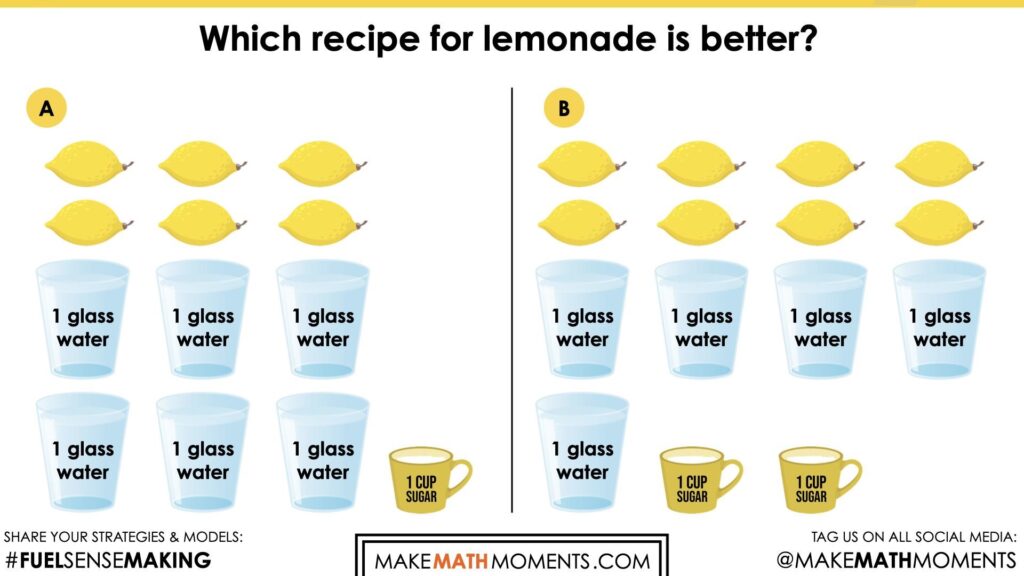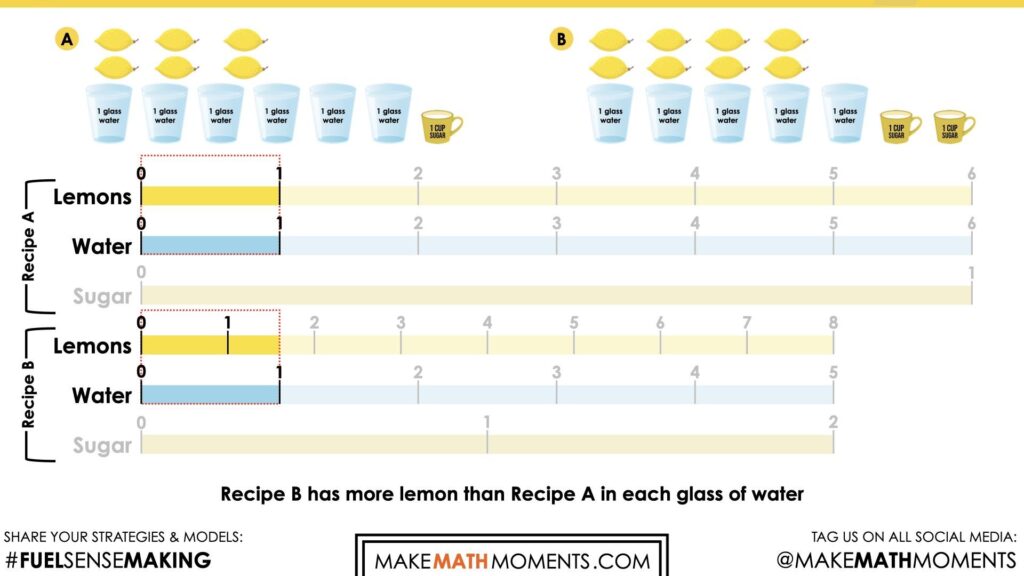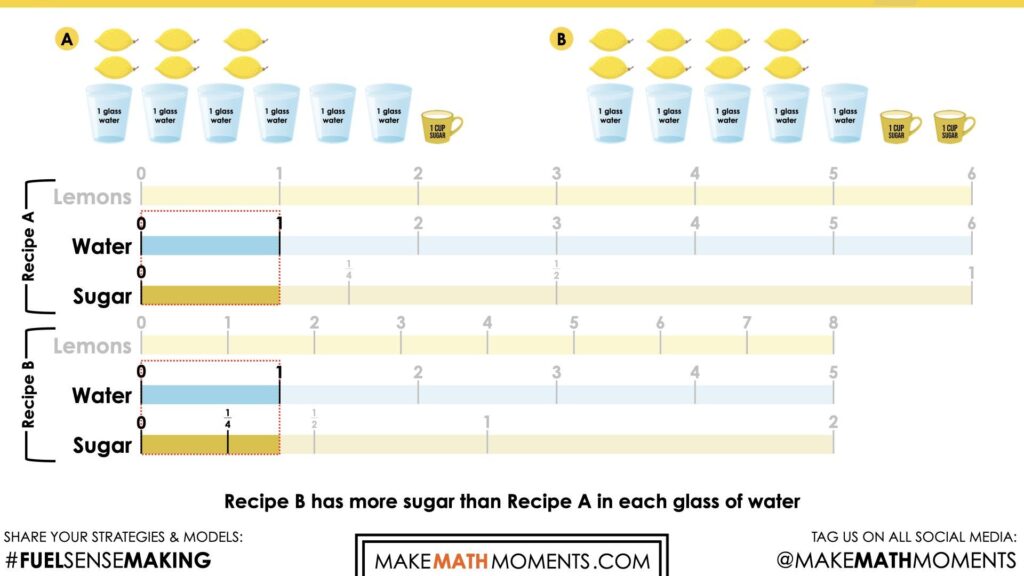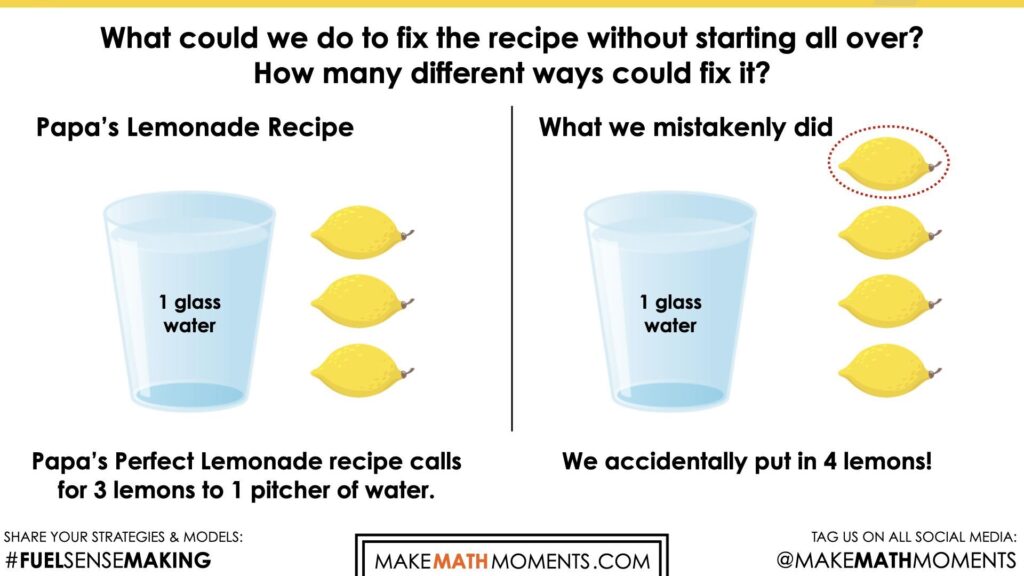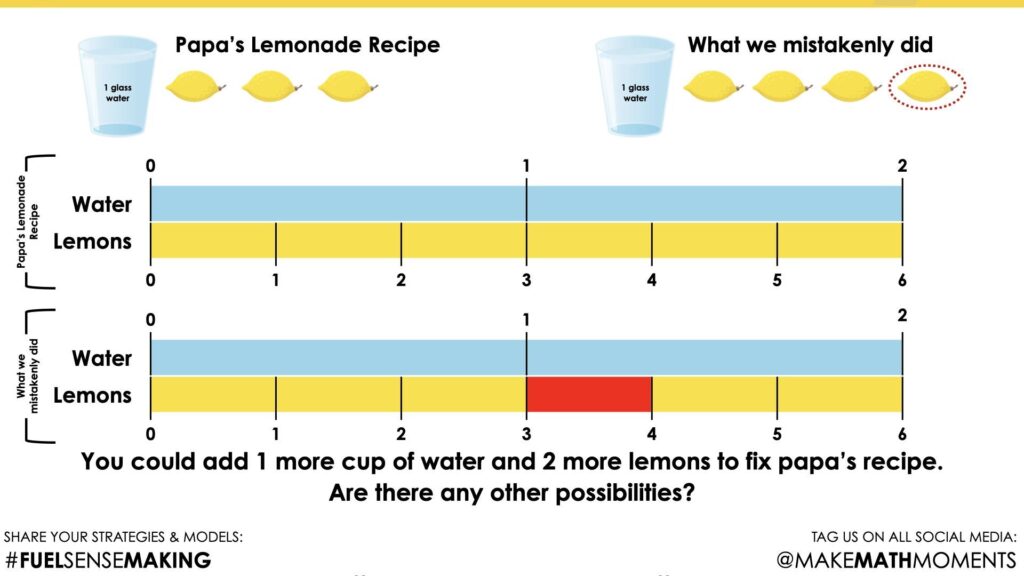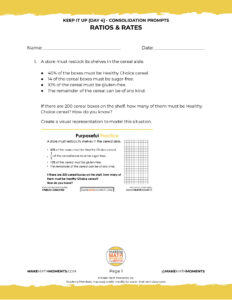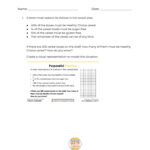Task Teacher Guide
Be sure to read the teacher guide prior to running the task. When you’re ready to run the task, use the tabs at the top of the page to navigate through the lesson.
In This Task…
Students will engage in warm up activities that will encourage them to think about ratios and the connection between various representations of quantities, including ratios, fraction representations and percents. They will explore how quantities covary and finding equivalent ratios as a strategy for comparison. Students will also continue to explore the connection between ratios and percents.
Intentionality…
The purpose of Day 4 activities is to reinforce and extend concepts from Day 3. Students will engage in visual number talk prompts that will encourage them to consider different ways to describe relationships between quantities, including the connections between sets, fraction representations and percents. They will also consider different types of ratios (part-to-part ratios and part-to-whole ratios).
Students will also have an opportunity to complete purposeful practice that will serve to develop a deeper understanding of the following big ideas:
- A ratio is a multiplicative comparison between two or more quantities;
- There are two types of ratios; a composed unit ratio and a multiplicative comparison ratio;
- A composed unit is often (not always) a ratio with two distinct units;
- Unknown quantities in a ratio relationship are often most efficiently revealed through multiplicative thinking strategies rather than additive thinking strategies;
- A composed unit ratio can be scaled in tandem;
- Ratios can be constructed by comparing a part to its whole (part-to-whole) or comparing a part to another part of the whole (part-to-part).
- Ratios can be represented using the separator “to” or a colon “:”. Two quantities from a ratio relationship can also be represented as a quotient through the use of the division symbol “÷” or with the fraction bar.
- When you divide two quantities in a composed unit ratio through partitive division, you reveal a rate.
- Equivalent ratios are derived from the same rate;
- An infinite number of equivalent ratios can be revealed to assist in determining an unknown quantity from a ratio relationship;
- Ratio problems can be represented and solved using a variety of strategies, tools, and representations; and,
- A multiplicative comparison ratio where one quantity, x, is compared to a whole of 100 can be written as a ratio (i.e.: x:100) or as a percent (i.e.: x%). Despite the rate language of “per” being used in the term “percent” (meaning per 100) as well as the common practice of using percents to describe growth or decay rates, a percent remains a ratio until the quantities are divided partitively.
What You’ll Need…
A variety of tools for students to use to think through the problems, including, but not limited to:
- Linking cubes, Omnifix cubes or tiles
- Cuisineaire rods
- Grid paper
- Whiteboards & markers
Visual Math Talk Prompts
String of Related Problems
On this day, there are a variety of visual math talk prompt options to select from. You might consider utilizing a single math talk, or possibly more than one. Alternatively, you might consider using these math talks over the next week or as a means to interleave and spiral throughout the school year.
The math talks are crafted in a way to foster discussion and the construction of viable arguments. As such, they are open ended and have more than one possible response.
Visual Math Talk Prompt #1
Consider utilizing the following image with the prompt:
Prompt:
Which lemonade recipe is better?
This question is deliberately open ended and may prompt some debate, depending on taste.
Some possible ideas students might share include:
- Recipe B would taste stronger, so it would be better.
- Recipe A has less sugar per cup so it’s healthier.
- Recipe A has 1 cup of sugar for 6 lemons, but recipe B has 1 cup for 4 lemons, so recipe B would be sweeter.
Of course, these are just some possible observations and many more ideas may be highlighted by your students.
Next, another prompt will be shared on the screen:
Which recipe is more “lemon-y”?
Which recipe is more “sugar-y”?
How could you convince someone you’re right?
Although there are a number of ways students can go about convincing you of which recipes are more lemon-y or more sugar-y, the use of a tape diagram or number line can be very helpful.
When comparing how lemon-y each recipe is, we can compare how many lemons there are for each part of water to determine which will have a more lemon-y taste. In this case, we can see that recipe B has more than 1 and a half lemons (8/5 lemons to be exact) for every 1 glass of water compared to 1 lemon for every 1 glass of water in recipe A.
When comparing which recipe is sweeter or more sugary, we can focus on how much sugar is in each recipe as compared to a single glass of water.
Very quickly, we can see from the original image that there were 2 cups of sugar for 5 glasses of water in recipe B whereas recipe A had a single cup of sugar in 6 glasses of water.
Looking on the tape diagram we can also see that recipe B must be more sugary as well.
Visual Math Talk Prompt #2
This extension prompt encourages students to consider equivalencies as they try to fix a Lemonade recipe that went wrong.
Watch the following video as Papa’s Perfect Lemonade recipe is introduced on the screen. When making the recipe, we accidentally added 1 extra lemon and now it is too lemon-y!
Students will be prompted with:
Papa’s Perfect Lemonade recipe calls for 3 lemons to 1 pitcher of water. We accidentally put in 4 lemons!
What could we do to fix the recipe without starting all over?
How many different ways could fix it?
Be convincing.
Although there are a number of different ways to “fix” this recipe without starting all over, one method that students might consider is adding an additional cup of water.
Since the recipe for 2 cups of water would require 6 lemons and our current 1 cup of water had 4 lemons added already, we could simply add the additional cup of water and 2 lemons to correct the recipe.
Of course we could scale up the recipe by any factor and simply ensure that we add 1 less lemon than the recipe would call for.
Visual Math Talk Prompt #3
Login/Join to access the full Math Talk, teacher guides, downloadable slide decks and printable handouts for this lesson and all problem based units.
Visual Math Talk Prompt #4
Login/Join to access the full Math Talk, teacher guides, downloadable slide decks and printable handouts for this lesson and all problem based units.
Visual Math Talk Prompt #5
Login/Join to access the full Math Talk, teacher guides, downloadable slide decks and printable handouts for this lesson and all problem based units.
Visual Math Talk Prompt #6
Login/Join to access the full Math Talk, teacher guides, downloadable slide decks and printable handouts for this lesson and all problem based units.
Visual Math Talk Prompt #7
Login/Join to access the full Math Talk, teacher guides, downloadable slide decks and printable handouts for this lesson and all problem based units.
Visual Math Talk Prompt #8
Login/Join to access the full Math Talk, teacher guides, downloadable slide decks and printable handouts for this lesson and all problem based units.
Visual Math Talk Prompt #9
Login/Join to access the full Math Talk, teacher guides, downloadable slide decks and printable handouts for this lesson and all problem based units.
Purposeful Practice
While Students are Practicing
Login/Join to access the full Math Talk, teacher guides, downloadable slide decks and printable handouts for this lesson and all problem based units.
Questions: Ratios and Percents
Login/Join to access the full Math Talk, teacher guides, downloadable slide decks and printable handouts for this lesson and all problem based units.
Download Editable/Printable Handout
Become a member to access purposeful practice to display via your projector/TV, download the PDF to upload to your LMS and/or print for students to have a physical copy
Resources and Downloads
Lesson Tip Sheet

Download the lesson plan in PDF format so you can keep it handy and share with colleagues.
Videos & Images
 Download the videos, images, and related media files to your computer to avoid streaming.
Download the videos, images, and related media files to your computer to avoid streaming.
Keynote Slides
 Download in Apple Keynote format to avoid streaming video and run the lesson smoothly.
Download in Apple Keynote format to avoid streaming video and run the lesson smoothly.
PowerPoint Slides
 Download in Microsoft PowerPoint format to avoid streaming video and run the lesson smoothly.
Download in Microsoft PowerPoint format to avoid streaming video and run the lesson smoothly.
Printable Handout
Download/Edit the handout so you can keep it handy and share with colleagues.
Explore The Entire Unit of Study
This Make Math Moments Task was designed to spark curiosity for a multi-day unit of study with built in purposeful practice, and extensions to elicit and emerge mathematical models and strategies.
Click the links at the top of this task to head to the other related lessons created for this unit of study.
Visual Math Talk Prompt #1
Visual Math Talk Prompt #2
Visual Math Talk Prompt #3
Login/Join to access the full Math Talk, teacher guides, downloadable slide decks and printable handouts for this lesson and all problem based units.
Visual Math Talk Prompt #4
Login/Join to access the full Math Talk, teacher guides, downloadable slide decks and printable handouts for this lesson and all problem based units.
Visual Math Talk Prompt #5
Login/Join to access the full Math Talk, teacher guides, downloadable slide decks and printable handouts for this lesson and all problem based units.
Visual Math Talk Prompt #6
Login/Join to access the full Math Talk, teacher guides, downloadable slide decks and printable handouts for this lesson and all problem based units.
Visual Math Talk Prompt #7
Login/Join to access the full Math Talk, teacher guides, downloadable slide decks and printable handouts for this lesson and all problem based units.
Visual Math Talk Prompt #8
Login/Join to access the full Math Talk, teacher guides, downloadable slide decks and printable handouts for this lesson and all problem based units.
Visual Math Talk Prompt #9
Login/Join to access the full Math Talk, teacher guides, downloadable slide decks and printable handouts for this lesson and all problem based units.
1. Stocking Cereal
Login/Join to access this full lesson, teacher guides, downloadable slide decks and printable handouts for this lesson and all problem based units.
2. Better Buy Doughnuts
Login/Join to access this full lesson, teacher guides, downloadable slide decks and printable handouts for this lesson and all problem based units.
3. Converting Currency
Login/Join to access this full lesson, teacher guides, downloadable slide decks and printable handouts for this lesson and all problem based units.
4. Vacation Abroad
Login/Join to access this full lesson, teacher guides, downloadable slide decks and printable handouts for this lesson and all problem based units.
5. Basketball Stats
Login/Join to access this full lesson, teacher guides, downloadable slide decks and printable handouts for this lesson and all problem based units.
Download Editable/Printable Handout
Become a member to access purposeful practice to display via your projector/TV, download the PDF to upload to your LMS and/or print for students to have a physical copy



